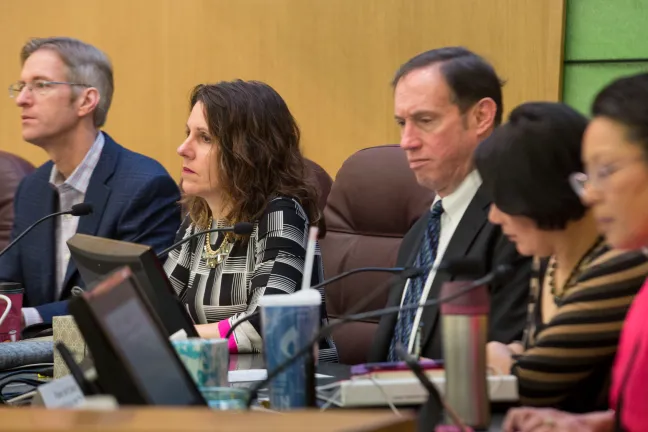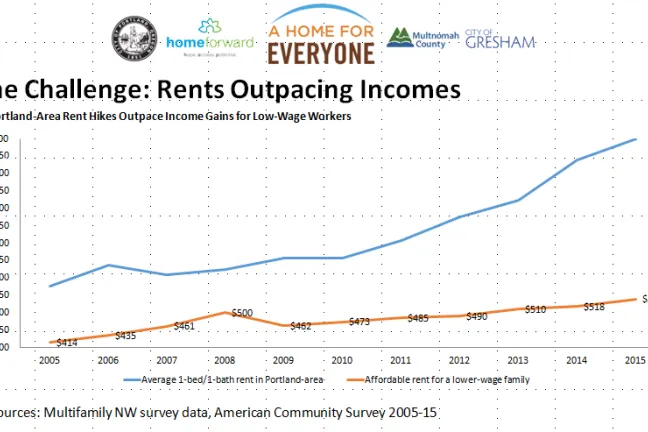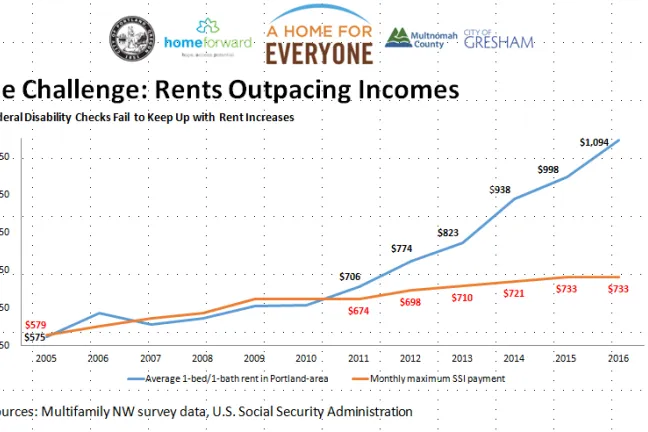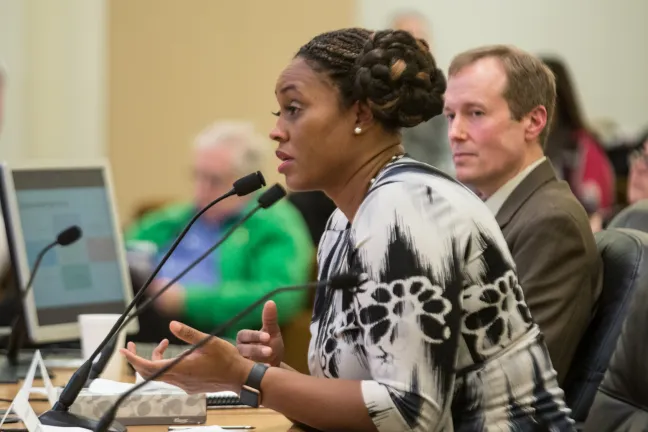Seven months after the City of Portland and Multnomah County joined forces to spend $30 million and create a coordinated office for attacking homelessness, that partnership has presided over a string of successes.
A dramatic expansion in day-and-night shelter capacity has helped hundreds more people find a safe place off the streets. Many more vulnerable young people, who are disproportionately people of color, were given a chance to find and keep stable homes.
Expanded help for victims of domestic violence has helped more Latinas back into housing, where they can begin the difficult work of healing and rebuilding their lives. And new funding for prevention programs has helped hundreds more people -- and especially people of color -- stay in housing or quickly regain it, avoiding the trauma of homelessness .
Those successes from the Joint Office of Homeless Services and its nonprofit partners stood out Tuesday during a rare combined session of the Multnomah County Board of Commissioners and Portland City Council.
They were shared by Marc Jolin, the Joint Office’s executive director, and leaders from service providers and culturally specific groups such as Self Enhancement Inc., El Programa Hispano Católico, New Avenues for Youth, JOIN and the Native American Rehabilitation Association.
“The eyes of homeless people all look the same, even though their skin color may be different,” said Libra Forde, chief operating officer of Self Enhancement Inc., which works with African American families experiencing homelessness. “Those eyes have finally found resources in places where they thought they were none.”
The briefing served as a progress report on the Joint Office, which formed in July 2016. It also offered a chance to review years of intense community collaboration as part of the A Home for Everyone initiative -- a partnership in which the city, county, businesses, faith leaders and community organizations pursue unified plans to end homelessness.
Commissioners all seemed to agree: New investments in prevention, shelter and housing placement -- overseen by the streamlined Joint Office -- are helping more neighbors than ever. They’re also nudging the region toward a system where homelessness might someday become rare, brief and one-time.
“Did it work?” asked Portland Commissioner Dan Saltzman. “It seems like it has.”
Lack of affordable housing drives families to the margins
But they also acknowledged some of the serious challenges still looming over the effort.
Oregon’s housing crisis and an economy that’s increasingly leaving behind people on the margins are driving people into homelessness faster than the city and county can lift them out of it -- even after last year’s historic investments.
Rising rents and no-cause evictions make it more likely families can’t afford their rent and risk falling into homelessness. That adds to the number of people who need services, while simultaneously making the services that would help the most -- rent assistance and housing placement -- more expensive to provide.
Jolin said the system could rely on adding shelter beds to grow its capacity -- something it’s done by the hundreds over the past year to reflect the reality on our streets.
But, he said, a reliable supply of affordable housing would make it easier to move more people through the shelter beds we already have. Adding shelter beds takes people off the streets. And yet, without housing, that wouldn’t make a long-term dent in overall homelessness.
“If someone is in an apartment where the rent is more than their income allows them to pay,” he said, “they’re going to lose that housing. Or they’re not going to be able to end that homelessness.”
In 2015, the last time volunteers and government officials counted people experiencing homelessness in Multnomah County, they reported some 4,000 people in shelter or on the streets. The count showed troubling increases in the number of people of color, women, victims of domestic violence and other groups vulnerable to rising rent prices. The next count is set to start in late February, with results due in late spring.
A Home for Everyone had sketched out a possible pathway toward halving the number of homeless people in the county by 2017. Jolin, director of the Joint Office, said that exercise assumed the rate of people becoming homeless would stay steady.
That likely hasn’t been the case.
“We’ll have to see,” he said. “We’re seeing a lot of new people in our system.”
Wage and employment challenges persist
Jolin showed charts that compared sharp rises in the Portland-area’s rental market against largely tepid gains in incomes and federal disability payments.
As recently as 2010, disability checks could cover rent in an average one-bedroom all on their own. Last fall, according to data from landlord advocacy group Multifamily NW, rent for a one-bedroom, one-bathroom apartment averaged $1,094 -- about $360 more than the top monthly federal disability check. About 18,700 adults in Multnomah County rely on those payments.
“There isn’t a unit in our market they can afford, except a regulated unit or a subsidized unit, if they get a voucher,” Jolin says. “And as you know, there are too few of them in our community right now.”
The gap for people making low-wages has also grown. In 2015, average rent was roughly $450 more than what someone making 30 percent of the median family income could afford without being considered cost-burdened.
“All of those challenges are greater for our communities of color,” Jolin said. “It’s the reason the commitment to racial equity is so strong in this initiative.”
Some of the providers on hand to address various facets of the homelessness services system -- families, victims of domestic violence, youths and single adults -- echoed Jolin’s concerns about the housing market.
“There’s more pressure on everybody,” said Sean Suib, executive director of New Avenues for Youth, which helps young people work through treatment and learn life skills on their way to jobs and housing opportunities. “That includes young people who are parenting.”
Patricia Rojas of El Programa Hispano Católico said higher rents have made it more difficult to place victims of domestic violence and free up precious space in shelters.
“There’s not enough housing resources in the domestic violence system or in general,” she said. “That’s the leading cause why it takes longer than we need” to place people.
Meanwhile, budget challenges in Salem, along with uncertainty in Washington, D.C., could slice further into a system that already doesn’t have enough money to help everyone who needs it.
“We’ve done so much in the last seven months, and there’s still so much to do,” said Multnomah County Chairwoman Deborah Kafoury. “We’re targeting all of the right places. But it’s going to take everyone in our community to help solve this problem.”
The Joint Office’s first seven months were marked by one other success: the region winning federal certification for ending veterans homelessness. By reaching “functional zero,” thanks to millions of dollars in federal funding and hundreds of housing vouchers, our community is able to ensure more veterans are leaving homelessness than entering it.
Springwater Corridor outreach and winter storms inform next steps
And the office also faced a pair of unprecedented events that have already shaped its work going forward.
Late last summer, city authorities led a cleanup of campsites along the Springwater Corridor that affected 300 to 500 people. The Joint Office spent months coordinating outreach and relocation help for the most vulnerable campers. Because of that experience, the office has added outreach workers.
Then, starting in December, the system has endured more than 30 days of severe weather through mid-February, as much as triple what it sees in a typical season. Four people experiencing homelessness died of exposure, tragedies that galvanized community support for outreach to help identify others in the elements and at risk.
Jolin presented fresh data and aired goals for the rest of 2017 that build on the office’s accomplishments.
The office is looking to deploy a mobile assessment team and add a pair of housing placement and retention teams. It’s also going to continue working with the Unity Center, the region’s new emergency center for people experiencing a mental health crisis, on developing a housing strategy.
“Those investments are getting out the door. They’re starting to show results,” Jolin said. “The work of this office touches so many departments and bureaus and the community.”




